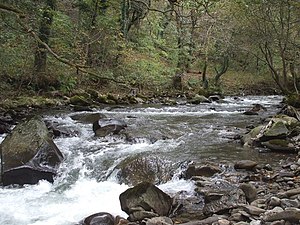River Afan

The River Afan (generally anglicized as Avon, and sometimes historically as Avan) is a river in Glamorgan, whose river valley formed the territory of the mediæval Lords of Afan. The town of Aberavon ("Mouth of the Avon") grew up on the banks of the river, and was later subsumed by the larger town of Port Talbot.
The river is about 11 miles long. Its valey, in common with many in Glamorgan, runs south to the sea. To the east over the hill is that of the River Kenfig and then the River Llynfi, a tributary of the River Ogmore.
Course
The river Afan begins its journey at the village of Cymer (meaning "confluence") where the rivers Corrwg and Gwynfi join. The river runs in a more or less south-westerly direction parallel to the River Neath. It converges with the Pelenna at Pontrhydyfen and from here it turns southward towards Port Talbot.
To aid the construction of the docks at Port Talbot, the river was diverted away slightly. Before it reaches the sea, the river drops over a 12-foot high vertical weir called the Slaughterhouse Falls.
The River passes the Afan Argoed Country Park in its middle reaches.
During the Middle Ages, a motte and bailey castle stood on the banks of the river as it passed through Aberavon, though no remains are now visible above ground. The site of the castle is nevertheless commemorated in local street names.
Industrial past
For much of the 19th century and the first half of the 20th century, the River Afan was severely polluted by the coal and iron industry. With the decline in the coal mining industry, the quality of the river improved in the 1960s and 1970s so that some salmon and sea-trout started to return to the river to spawn. A number of weirs on the river, built to sustain the industrial past, had to be made passable to allow fish to ascend the river. This required the creation of fish passes on some weirs such as on the Dock feeder weir and the demolition of others such as at Corlannau weir.
Tributaries
Afon Corrwg
The river Corrwg is one of the two rivers to form the Afan. Its length is approximately 7 miles, and its source lies in the hills south of Glyn-neath. It has one major tributary called the Afon Corrwg Fechan, as well as other numerous streams. The river is known for the numerous waterfalls along its length. Although the water is clear today, discharge from the many collieries along its lower reaches led to noticeable pollution. Minor discharge sometimes leaks from the Glyncorrwg colliery, although its effects do not have a noticeably detrimental effect on the river.
Afon Gwynfi
The Afon Gwynfi joins the Corrwg at Cymer. It is 5 miles long, and starts at Blaengwynfi, where two small rivers join. Its source is only a couple of miles away from that of the rivers Rhondda and Ogmore. Maps have on occasion confused the Gwynfi and the Afan itself; which one may claim to be the genuine Afan may be disputed I the headwaters. Generally speaking though, the spring of the Afan is held to be Blwch-yr-Afan, (which means "Source of the Afan").
The river is slightly alkaline due to continuing, albeit minor, pollution discharge from the Corrwg Rhondda and Glyncorrwg collieries. [1]
River Pelenna
A major tributary, the River Pelenna,which meets the Afan at Pontrhydyfen, suffered more severely from pollution than the main river because of the sulphur-rich coal produced by the mines in that area. As a result, the abandoned coal mines continued to discharge acid mine drainage rich in iron and highly acidic. This turned much of the river orange down to the confluence of the Pelena with the main river Afan. The Orange colour could often be seen as far down stream as Pontrhydyfen. There were a number of collieries contributing to the pollution although the major source was the Whitworth Colliery.[2] At the height of coal extraction in the valley, there were several deep pits and numerous levels. This pollution is now much mitigated[3] following extensive work promoted by the Environment Agency in the creation of engineered reed beds to treat the mine drainage.
Nant Ffrwdwyllt
With a length of just under 5 miles, this was a small tributary of the Afan shortly before it entered the sea. The Nant Ffrwdwyllt was diverted in the 18th century into the ironworks at what was to become Port Talbot to provide a source of water. It remains diverted flowing into the Port Talbot Docks.
References
- ↑ Gwynfi Mine Water Treatment Scheme - The Coal Authority
- ↑ List of Coal Mines in Great Britain and the Isle of Man, 1908
- ↑ TI: Proceedings of CIWEM Conference on 'Minewater Treatment Using Wetlands SO: Water and Environment Journal VL: 12 NO: 1 PG: 68-69 YR: 1998 ON: 1747-6593 PN: 1747-6585 DOI: 10.1111/j.1747-6593.1998.tb00150.x US: http://dx.doi.org/10.1111/j.1747-6593.1998.tb00150.x